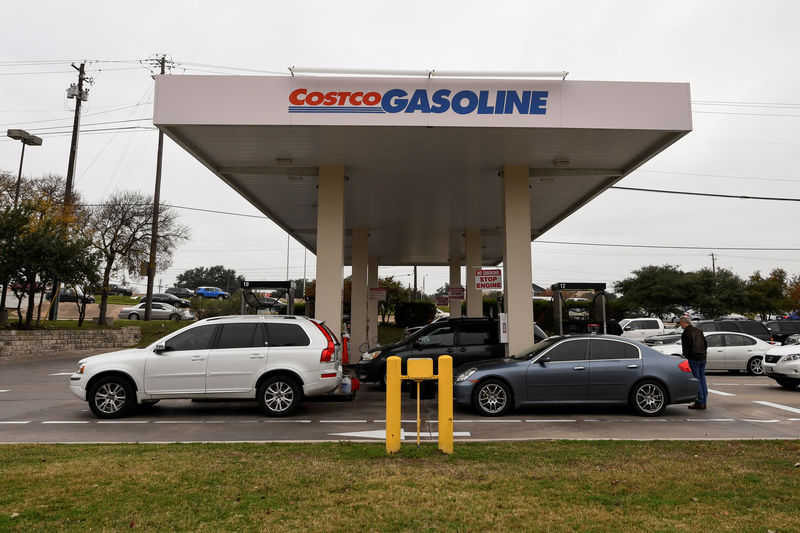By Lucia Mutikani
WASHINGTON (Reuters) - U.S. consumer prices fell for the first time in nine months in December amid a plunge in gasoline prices, but underlying inflation pressures remained firm as rental housing and healthcare costs rose steadily.
Overall, the report from the Labor Department on Friday painted a picture of inflation that was under control, with increases in some categories offset by declines elsewhere. This likely supports recent statements by Federal Reserve officials pledging patience in raising interest rates this year.
"The Fed will take this as further proof that price pressures are building more slowly than some have feared based on the strong growth of late and tight labor market," said James McCann, senior global economist at Aberdeen Standard Investments in Boston. "It certainly seems to justify the Fed's message about being more patient on rate increases."
The Consumer Price Index dipped 0.1 percent last month, the first drop and weakest reading since March, after being unchanged in November. In the 12 months through December, the CPI rose 1.9 percent, slowing from November's 2.2 percent gain.
Excluding the volatile food and energy components, the CPI increased 0.2 percent, advancing by the same margin for a third straight month. In the 12 months through December, the so-called core CPI rose 2.2 percent, matching November's increase.
December's inflation readings were in line with economists' expectations. The CPI rose 1.9 percent in 2018, slowing from a 2.1 percent increase in 2017. But the core CPI jumped 2.2 percent, up from 1.8 percent in 2017.
The Fed, which has a 2 percent inflation target, tracks a different measure, the core personal consumption expenditures (PCE) price index, for monetary policy.
The core PCE price index increased 1.9 percent year-on-year in November after rising 1.8 percent in October. It hit 2 percent in March for the first time since April 2012.
The U.S. central bank has forecast two interest rate hikes this year, but several policymakers, including Chairman Jerome Powell, have said they would be cautious about tightening monetary policy.
Powell reiterated that view on Thursday, saying "especially with inflation low and under control we have the ability to be patient and watch patiently and carefully" while the central bank monitored economic data and financial markets for risks to growth.
Minutes of the U.S. central bank's Dec. 18-19 policy meeting published on Wednesday showed "many" officials were of the view that the Fed "could afford to be patient about further policy firming."
But with core inflation remaining firm despite a strong dollar and slowing global growth, economists say further rate increases this year cannot be ruled out. In addition, a tighter labor market is boosting wage growth.
"If core inflation holds firm, the Fed will continue to consider additional rate hikes this year," said Sam Bullard, a senior economist at Wells Fargo (NYSE:WFC) Securities in Charlotte, North Carolina.
The Fed lifted borrowing costs four times in 2018. The dollar was little changed against a basket of currencies, while U.S. Treasury prices rose. Stocks on Wall Street were trading lower after a five-day rally.
BOOST TO PURCHASING POWER
Low inflation is boosting households' purchasing power, which could keep consumer spending supported. While the economy likely posted strong growth in the fourth quarter, an ongoing partial shutdown of the federal government is casting a cloud on the economy.
The partial closure started on Dec. 22 as President Donald Trump demanded that the U.S. Congress give him $5.7 billion this year to help build a wall on the U.S. border with Mexico.
According to JPMorgan (NYSE:JPM) the shutdown, which has left 800,000 employees furloughed or working without pay and delayed the release of data from the Census Bureau and Bureau of Economic Analysis, was subtracting 0.1-0.2 percentage point from quarterly gross domestic product growth each week.
Inflation-adjusted average weekly earnings surged 0.7 percent in December, the biggest gain since August 2015, after slipping 0.1 percent in November. Weekly earnings increased 1.2 percent in the 12 months to December, the most since July 2016, from 0.6 percent in November.
Last month, gasoline prices dropped 7.5 percent, the largest decrease since February 2016, after tumbling 4.2 percent in November. But Americans paid more for food, with prices rising 0.4 percent. That was the biggest gain since May 2014 and followed a 0.2 percent rise in November.
Owners' equivalent rent of primary residence, which is what a homeowner would pay to rent or receive from renting a home, advanced 0.2 percent in December after rising 0.3 percent in November. Healthcare costs increased 0.3 percent last month after jumping 0.4 percent in November.
Apparel prices were unchanged in December after dropping 0.9 percent in the prior month. Airline fares tumbled 1.5 percent and prices for used motor vehicles and trucks fell 0.2 percent after rising for two straight months.

But prices for household furnishings increased, likely because of tariffs imposed by the Trump administration on a range of imported Chinese goods. New motor vehicle prices were unchanged for a second straight month.